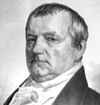
The 17th United States Congress was a meeting of the legislative branch of the United States federal government, consisting of the United States Senate and the United States House of Representatives. While its term was officially March 4, 1821, to March 4, 1823, during the fifth and sixth years of James Monroe's presidency, its first session began on December 3, 1821, ending on May 8, 1822, and its second session began on December 2, 1822, to March 3, 1823. The apportionment of seats in the House of Representatives was based on the 1810 United States census. Both chambers had a Democratic-Republican majority.
Ohio's at-large congressional district existed from 1803 to 1813, from 1913 to 1915, from 1933 to 1953 and from 1963 until 1967, when it was banned by the Voting Rights Act of 1965.
These are tables of congressional delegations from Vermont to the United States Senate and United States House of Representatives.

North Dakota's at-large congressional district is the sole congressional district for the state of North Dakota. Based on size, it is the eighth largest congressional district in the nation.

Vermont has been represented in the United States House of Representatives by a single at-large congressional district since the 1930 census, when the state lost its second seat, obsoleting its 1st and 2nd congressional districts. There were once six districts in Vermont, all of which were eliminated after various censuses.
Vermont's 1st congressional district is an obsolete district. Vermont currently has one representative to the United States House of Representatives, elected statewide at-large. Until 1933, however, the state used to have multiple seats spread out into geographic districts. During that time, the first district elected its own representative.

Pennsylvania's first congressional district includes all of Bucks County and a sliver of Montgomery County in southeastern Pennsylvania. It has been represented by Brian Fitzpatrick since 2019.
From its statehood in 1816 until 1823, Indiana was allocated only one representative, who was elected at-large. During the 43rd Congress, from 1873 to 1875, Indiana elected three of its thirteen representatives to the United States House of Representatives at-large from the entire state.
New York's 21st congressional district is a congressional district for the United States House of Representatives that is represented by Republican Elise Stefanik.
Beginning from its inception into statehood, New Jersey elected its representatives at-large instead of from individual districts. This continued for most years until 1843, with the exception of the years 1799-1801, and 1813-1815 when they were elected in districts. After 1843, New Jersey returned to district representation. Four at-large representatives were elected in 1789 until 1793 when a 5th representative was added. 6 seats were allocated beginning in 1803, continuing until at-large representation ceased in 1843.
From the time of its admission to the Union in 1812, until the division into multiple districts a decade later, Louisiana had only one congressional district. During that time, three people represented the state at-large.
During the first twenty-four Congresses, Connecticut elected all its representatives in Congress from a single multi-member Connecticut at-large congressional district.
The New Hampshire at-large congressional district is obsolete, with representation having since been divided into districts.
From 1793 to 1827 and again from 1829 to 1845, Georgia elected all its Representatives in Congress from a single multi-member at-large congressional district:
From the state's creation August 10, 1821 until the end of the 29th United States Congress, and also for the 73rd Congress (1933–1935), Missouri elected its members of the United States House of Representatives at-large statewide on a general ticket.
During the 35th through 37th Congresses, Minnesota elected its two members of the United States House of Representatives at-large statewide on a general ticket. Minnesota then elected a member to an at-large seat 1913-1915, with the remaining nine representatives elected in districts. Minnesota elected all its members at large for the 73rd Congress, ending the practice two years later.
Vermont's 2nd congressional district is an obsolete district. It was created upon Vermont's admission as the 14th state in 1791. It was eliminated after the 1930 census. Its last congressman was Ernest W. Gibson, who was redistricted into the at-large district.
Vermont's 5th congressional district is an obsolete district. It was created in 1821. It was eliminated after the 1840 census. Its last congressman was John Mattocks.
Oklahoma's 7th congressional district was a district that existed from 1915 through 1953, covering the southwestern portion of the state.





